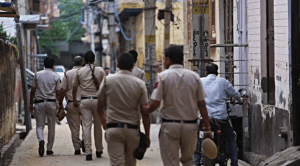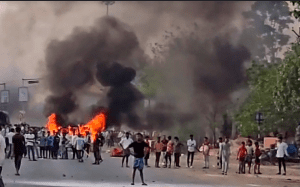ONGC Factory Fire in Domjur: A massive fire broke out at an ONGC factory located in Domjur, Howrah district, West Bengal, on April 21, 2025, triggering panic among local residents and drawing a swift response from emergency services. The incident occurred in the industrial belt of Domjur, a key hub for petrochemical and manufacturing activity in the region. Although no casualties have been reported so far, the scale of the blaze and its proximity to residential areas raised significant concerns about industrial safety and environmental hazards.
The fire reportedly started in a section of the factory that handles petrochemical processing. Eyewitnesses described thick black smoke billowing into the sky, visible from several kilometers away. Firefighters rushed to the scene with multiple fire tenders and were engaged in hours-long operations to douse the flames and prevent the blaze from spreading to adjacent structures.
As investigations begin into the cause of the fire, attention has turned toward ONGC’s safety protocols, past records of similar incidents, and the adequacy of the state’s industrial disaster response systems
Background: What is the ONGC Facility in Domjur?
The Oil and Natural Gas Corporation (ONGC), one of India’s largest public sector enterprises, operates various auxiliary facilities across the country that support its energy exploration and processing operations. The Domjur unit in Howrah district is believed to be involved in either storage or auxiliary petrochemical processes, possibly related to gas dehydration or material handling for downstream units.

While not as high-profile as ONGC’s offshore platforms or major refineries, such installations play a critical role in the energy value chain. Their operations often involve hazardous materials, making stringent safety standards a necessity.
Domjur has, over the years, developed as a secondary industrial corridor with a blend of state-supported and private sector manufacturing units. The presence of such sensitive installations in densely populated areas has always been a matter of public safety discussion — one that will now be revisited with renewed urgency.
Timeline of the Fire Incident at ONGC Factory in Domjur
According to available reports and eyewitness accounts, the fire at the ONGC facility in Domjur unfolded in a series of alarming developments throughout the day on April 21, 2025. Here’s a detailed reconstruction of the sequence of events based on preliminary information:
10:45 AM – Initial Signs of Trouble
Factory workers reportedly noticed an unusual hissing sound followed by the smell of burning chemicals in one of the storage units. Within minutes, smoke began to emanate from the eastern section of the complex.
11:10 AM – Fire Alarm Triggered
The in-house emergency alarm was activated as flames became visible. ONGC’s internal safety team initiated standard fire containment procedures, including the use of extinguishers and foam sprays, but failed to control the rapidly escalating blaze.
11:30 AM – Local Fire Brigade Alerted
The factory management alerted the West Bengal Fire and Emergency Services Department. Fire stations from Howrah, Bally, and Kolkata were placed on high alert. The first fire tender arrived on-site within 20 minutes.
12:15 PM – Fire Spreads to Adjacent Storage Zones
Despite early efforts, the fire spread to nearby storage tanks containing flammable chemicals. Large explosions were reportedly heard, prompting the evacuation of nearby residences and factory workers.
1:00 PM – Media and Police Arrive
News crews and law enforcement began arriving at the site. Police cordoned off surrounding areas to prevent civilian access and facilitate emergency operations. Domjur Police Station and Howrah District authorities coordinated crowd control.
2:00 PM – Fire Under Control
By mid-afternoon, after nearly three hours of relentless firefighting, the flames were largely brought under control. Residual smoke and chemical fumes continued to pose hazards, prompting the use of aerial water sprays and chemical neutralizers.
3:30 PM – Cooling Operations Begin
Firefighters initiated the cooling process to ensure there were no reignitions. Thermal cameras were used to monitor hot zones in the facility.
Evening – Preliminary Inspection Begins
Officials from ONGC, the West Bengal Pollution Control Board (WBPCB), and the local administration began preliminary site inspections. No casualties were confirmed, but extensive property damage was evident.
ONGC Factory Fire in Domjur: Eyewitness Accounts & Ground Reports
As smoke continued to rise from the ONGC facility in Domjur, local residents and factory workers provided chilling firsthand accounts of the terrifying moments that unfolded. Their testimonies paint a vivid picture of panic, confusion, and the dramatic response that followed.
Panic Among Local Residents
Soma Bhowmik, a resident of a nearby housing colony, described the chaos:
“I was at home when I heard a loud bang. I ran to the window and saw a huge fireball in the sky. Within minutes, the area was filled with thick black smoke. We thought there had been a blast.”
Residents rushed out of their homes fearing a chemical explosion, and some fled with children and elderly family members. Many complained of breathing difficulties due to the smoke, while others feared a secondary explosion.
Factory Workers Speak Out
One of the factory employees, who requested anonymity, claimed that the fire suppression systems were “not fully operational,” and the initial efforts to contain the fire were “slow and disorganized.”
“We have fire extinguishers, but we were not trained for this scale of emergency. The flames spread too fast. We just ran for our lives,” he said.
Another worker added that safety drills had not been conducted in months, a claim ONGC has yet to confirm or deny.
Firefighting Efforts and Response from Authorities
As the fire engulfed sections of the ONGC facility in Domjur, emergency response teams sprang into action. The West Bengal Fire and Emergency Services Department played a pivotal role in preventing what could have been a catastrophic escalation.
Rapid Deployment of Fire Tenders
Within half an hour of the first distress call, multiple fire engines from nearby Howrah and Kolkata stations arrived. Officials confirmed the deployment of at least eight fire tenders, including high-capacity foam units specialized for chemical and petrochemical fires. Firefighters worked tirelessly under intense heat and toxic smoke, rotating shifts to prevent exhaustion.
A senior fire officer on the scene stated:
“The presence of flammable chemicals meant we had to act quickly. Foam and dry powder were used to suppress chemical reactions while water jets targeted the periphery to prevent spread.”
ONGC Factory Fire in Domjur: Police and Disaster Management Coordination
Domjur Police, along with the Howrah District Disaster Management Authority, established a safety perimeter to prevent civilian exposure. Evacuation orders were issued for nearby homes and small factories. The police also assisted in diverting traffic from nearby roads, ensuring uninterrupted access for emergency vehicles.


Senior administrative officials, including the Howrah District Magistrate, arrived at the site to coordinate efforts. Rajeev Kumar, the Chief Secretary of West Bengal, was briefed in real-time.


Medical Preparedness
Ambulances and mobile medical units were placed on standby, although no injuries were reported by late evening. Hospitals in the vicinity, including Howrah General and a private multispecialty center, were placed on high alert.
Casualty & Damage Report (So Far)
As of the latest official updates, there have been no reported casualties or injuries resulting from the ONGC factory fire in Domjur. This has come as a major relief to both authorities and local residents, especially given the massive scale and volatility of the blaze. However, the material damage appears extensive.
No Loss of Life, But Significant Property Damage
Officials from the West Bengal Fire Department confirmed that quick evacuation measures and the timing of the incident—occurring during a lower-occupancy phase—helped avert a tragedy. Several workers were safely evacuated before the fire spread to the main operational units.
Despite the absence of human casualties, a preliminary damage assessment indicates:
- Multiple storage units and chemical tanks destroyed
- Damage to infrastructure worth several crores
- Power and control panels within the facility burned or melted
- Structural integrity of adjacent buildings compromised
Environmental Concerns Raised
Although no toxic leaks were immediately reported, plumes of black smoke containing chemical residues were released into the atmosphere. Residents in surrounding areas have complained of respiratory irritation, and the West Bengal Pollution Control Board (WBPCB) is expected to conduct air and soil quality assessments in the coming days.
Assessment Teams Mobilized
ONGC has formed a special internal committee to assess the total loss and begin planning for reconstruction. Meanwhile, state disaster teams and independent insurance surveyors have started documenting the extent of the damage for claims and accountability.
Political Reactions & Administrative Comments
In the wake of the ONGC factory fire in Domjur, political leaders across party lines and government officials have responded with concern, criticism, and calls for accountability. The incident has sparked renewed debate around industrial safety regulation, state oversight, and corporate responsibility in West Bengal.
State Government Response
The West Bengal Chief Minister, Mamata Banerjee, was quick to react, directing the Howrah District Magistrate to submit a full report within 48 hours. She also assured the public that there would be no cover-up and that anyone found negligent—whether ONGC personnel or local officials—would face consequences.
“We cannot take industrial safety lightly. A detailed probe will be conducted. The safety of our citizens is non-negotiable,” said a senior state minister during a press briefing.


Opposition Criticism
Opposition leaders from the BJP and CPI(M) criticized both ONGC and the state government. They accused the administration of failing to enforce safety norms and conducting “token inspections” that do little to prevent such disasters.
BJP’s Howrah district spokesperson demanded a Central Industrial Safety Audit, saying:
“This is not the first time West Bengal has witnessed an industrial fire. It shows systemic failure and negligence.”
Central Government Involvement
While ONGC falls under the jurisdiction of the central Ministry of Petroleum and Natural Gas, the Union government has not yet issued a formal statement, though sources suggest that the Petroleum Safety Organization (PESO) will soon be roped in for technical investigation.
A central fact-finding team is expected to visit Domjur later this week.
Industrial Fires in West Bengal – A Recurring Pattern?
The ONGC factory fire in Domjur has once again spotlighted a concerning pattern: the recurrence of industrial fires in West Bengal’s densely populated manufacturing belts. Over the past decade, the state has witnessed multiple incidents involving hazardous chemical units, unauthorized warehouses, and even government-owned industrial facilities.
Notable Past Incidents
- 2019: A fire at a fireworks storage facility in South 24 Parganas resulted in 9 deaths, exposing illegal storage practices.
- 2021: A plastic manufacturing unit in Topsia, Kolkata, caught fire due to a short circuit, triggering mass evacuations.
- 2023: A blaze at a chemical godown in Tangra caused widespread panic, prompting state fire services to reevaluate inspection protocols.
These incidents suggest that fire safety audits, while mandated by law, may often be conducted superficially or infrequently, especially in small and medium-scale industrial clusters.
Common Causes and Systemic Failures
Experts cite a combination of factors for these recurring fires:
- Lack of fire exits and evacuation signage
- Use of non-standard electrical wiring
- Poor storage of flammable substances
- Infrequent maintenance of fire suppression equipment
- Inadequate training of factory staff
Despite multiple warning signs and loss of life in earlier cases, critics argue that little has changed on the ground, especially in semi-urban areas like Domjur.
Policy Recommendations Ignored?
Following each major fire, policy reviews are promised, and committees are formed. However, implementation often falls short due to bureaucratic delays, lack of coordination between state agencies, and limited enforcement powers of regulatory bodies like the Directorate of Factories.
The ONGC fire has now become a symbolic test case—whether West Bengal will finally overhaul its industrial safety ecosystem, or whether it will become just another entry in a long list of neglected warnings.
The Road Ahead – Rebuilding and Future Preventive Measures
The fire at the ONGC factory in Domjur serves as a wake-up call for both industry leaders and regulatory bodies. As the smoke clears and initial investigations unfold, it’s crucial for ONGC and the state government to focus on rebuilding the facility and implementing robust preventive measures.
Rebuilding the Facility
ONGC will need to assess the structural integrity of the damaged buildings, particularly the storage and processing units, and begin the reconstruction process. The company must prioritize safety, ensuring that the new infrastructure meets the highest standards of industrial safety.
Strengthening Safety Protocols
Going forward, ONGC must overhaul its safety protocols, including conducting frequent emergency drills and updating fire suppression systems. Employee training should be made mandatory and regularly updated to ensure that workers are prepared for worst-case scenarios.
Industry-Wide Reforms
In the aftermath of this tragedy, industry experts argue that there should be a systematic overhaul of safety regulations across the entire petroleum sector. ONGC, along with other companies, should collaborate with the government to ensure stricter safety audits, better disaster management practices, and improved worker welfare.

